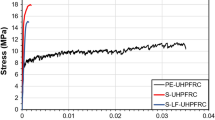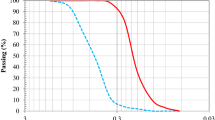Abstract
A number of three-point bending and fracture tests of 200 MPa-level reactive powder concrete (RPC) with the various fiber contents have been conducted to probe the nature and characteristics of toughness of RPC200. The contribution of the embedded fibers to improving the crack-resistant capacity, energy absorption capacity and toughness with various deformation mechanisms has been analyzed. Taking account of that the first-crack deformation, peak-load deformation and their improvement varied with the fiber contents and that the deformation mechanism affected differently the performance at the first crack and the peak load, we took the peak-load deformation of plain RPC200 as the reference deformation to measure the toughness of fibered RPC200. Two toughness indices T 2(n−1)(n) and FT 2(n−1)(n) have been formulated based on P-δ responses and P-CMOD responses. The indices quantify the toughness of RPC200 with the various deformation mechanisms relative to perfectly elastoplastic materials by setting the toughness level 2(n−1) as the initial reference. It is shown that the toughness index T 2(n−1)(n) reflects the function of fibers to improve the toughness of RPC with the deformation throughout specimens, but overestimates the contribution to enhancing the toughness in post-peak periods. It underestimates, on other hands, the contribution to improving the toughness in the period from the first crack to the peak load. In contrast, the toughness index FT 2(n−1)(n) properly presents the capability that fibers absorb energy and constrain crack propagation in the matrix when the deformation is concentrated on the open crack. The proposed index unveils the contribution of fibers to toughening RPC200 both in the period from the first-crack to the peak load and in the period of post peak. This characterization method not only reveals the nature of toughness but also levels the toughness of RPC200. It could provide a way to establish an objective toughness characterization for RPC200 and facilitate its applications.
Similar content being viewed by others
References
Shaheen E, Shrive N G. Optimization of mechanical properties and durability of reactive powder concrete. ACI Mater J, 2006, 103(6): 444–451
Bayard O, Plé O. Fracture mechanics of reactive powder concrete: Material modelling and experimental investigations. Engng Fract Mech, 2003, 70(7–8): 839–851
Dugat J, Roux N, Bernier G. Mechanical properties of reactive powder concretes. Mater & Struct, 1996, 29(188): 233–240
Richard P, Cheyrezy M. Composition of reactive powder concretes. Cem Concrete Res, 1995, 25(7): 1501–1511
Richard P, Cheyrezy M. Reactive powder concrete with high ductility and 200–800 MPa compressive strength. ACISP144, 1994, 507–518
Ju Y, Jia Y D, Liu H B, et al. Mesomechanism of steel fiber reinforcement and toughening of reactive powder concrete. Sci China Ser E-Tech Sci, 2007, 37(11): 1403–1416
Ge T, Pan Y F, Tan K K, et al. Study on resistance of reactive powder concrete to impact (in Chinese). J Rock Mech Eng, 2007, 26(S1): 3553–3557
Yao Z X, Zhou J, Zhou R Z. Experimental study on fracture properties of reactive powder concrete (RPC) (in Chinese). J Building Mater, 2006, 9(6): 654–659
Yu Z R, Yan G P. Fracture mechanics of reactive powder concrete (in Chinese). J Chin Saf Sci, 2005, 15(8): 101–104
ASTM. Standard test method for flexural toughness and first-crack strength of fiber reinforced concrete (using beam with third-point loading). ASTM C 1018, 1997, ASTM Inter, West Conshohocken, Pa, 7
EFNARC. Specification for sprayed concrete (final draft). European federation of national associations of specialist contractors and material supplies to the construction industry (EFNARC), Hampshire, UK, Oct 1993, 35pp
ACI Committee 544, Measurement of properties of fiber reinforced concrete. ACI Mater J, 1988, 85: 583–593
JCI. Method of test for flexural strength and flexural toughness of fiber reinforced concrete, JCI Standard SF-4. Japan concrete institute standards for test methods of fiber reinforced concrete, Tokyo, Japan, June 1984, 45–51
People’s Republic of China building industry profession standard. Steel Fiber Reinforced Concrete JG/T 3064-1999. Beijing: Ministry of Construction of the People’s Republic of China, December, 1999
People’s Republic of China building industry profession standard. The Standards for Steel Fiber Reinforced Concrete Test: CECS 13:89 (in Chinese). Beijing: China Association for Engineering Construction Standardization, 1989 (CECS), 58p. in December, 1989
China Association for Engineering Construction Standardization. Technical Specification for Fiber Reinforced Concrete Structures CECS 38-2004. Beijing: Chinese Plan Publishing House, 2004
El-Ashkar N H, Kurtis K E. A new simple practical method to characterize toughness of fiber-reinforced cement-based composites. ACI Mater J, 2006, 103(1): 33–44
Banthia N, Mindess S. Toughness characterization of fiber-reinforced concrete: Which standard to use? J Testing & Evalu, 2004, 32(2): 1–5
Banthia N, Dubey A. Measurement of flexural toughness of fiber reinforced concrete using a novel technique, Part 1: Assessment and calibration. ACI Mater J, 1999, 96(6): 651–656. and Part 2: Performance of various composites. ACI Mater J, 2000, 97(1): 3–11
Taylor M, Lydon F D, Barr B I G. Toughness measurements on steel fibre-reinforced high strength concrete. Cem Concrete Comp, 1997, 19(4): 329–340
Barr B, Gettu R, Al-Oraimi S K A, et al. Toughness measurement-the need to think again. Cem Concrete Comp, 1996, 18(4): 281–297
Johnston C D. Deflection measurement considerations in evaluating FRC performance using ASTM C 1018. Testing of Fiber Reinforced Concrete, SP-155. Stevens et al., eds. American Concrete Institute, 1995, Farmington Hills, Mich, 1–22
Chen L, Mindess S, Morgan D R, et al. Comparative toughness testing of fiber reinforced concrete. Testing of Fiber Reinforced Concrete, SP-155. Stevens et al., eds. American Concrete Institute, 1995, Farmington Hills, Mich, 41–75
Banthia N, Trottier J F. Test methods for flexural toughness characterization of fiber reinforced concrete: Some concerns and a proposition. ACI Mater J, 1995, 92(1): 48–57
Gopalaratnam V S. On the characterization of flexural toughness in fiber reinforced concretes. Cem Concrete Comp, 1995, 17(3): 239–254
Mindess S, Chen L, Morgan D R. Determination of the first-crack strength and flexural toughness of steel fiber reinforced concrete. Advn Cem Bas Mat, 1994, 1(5): 201–208
Johnston C D. Discussion to fracture toughness of fiber reinforced concrete by V. S. Gopalaratnam, S. P. Shah, G B Batson, M E Criswell, V. Ramakishnan and M. Wecharatana. ACI Mater J, 1992, (5–6): 304–309
Gopalaratnam V S, Shah S P, Batson G B, et al. Fracture toughness of fiber reinforced concrete. ACI Mater J, 1991, 88(4): 339–353
Chen J. Study on Bending and Fracture Mechanical Properties of Reactive Powder Concrete (in Chinese). MSc Thesis. Beijing: China University of Mining & Technology, 2006
Author information
Authors and Affiliations
Corresponding author
Additional information
Supported by the New Century Excellent Talents Program (Grant No. NCET-05-0215), the Natural Science and Engineering Research Council of Canada (Grant No. PGS D2 2006), the Laboratory Innovation Plan of Beijing Science and Education Committee (Grant No. JD102900671) and the National Basic Research Project of China (“973” Project) (Grant No. 2002CB412705)
Rights and permissions
About this article
Cite this article
Ju, Y., Liu, H., Chen, J. et al. Toughness and characterization of reactive powder concrete with ultra-high strength. Sci. China Ser. E-Technol. Sci. 52, 1000–1018 (2009). https://doi.org/10.1007/s11431-009-0084-6
Received:
Accepted:
Published:
Issue Date:
DOI: https://doi.org/10.1007/s11431-009-0084-6




